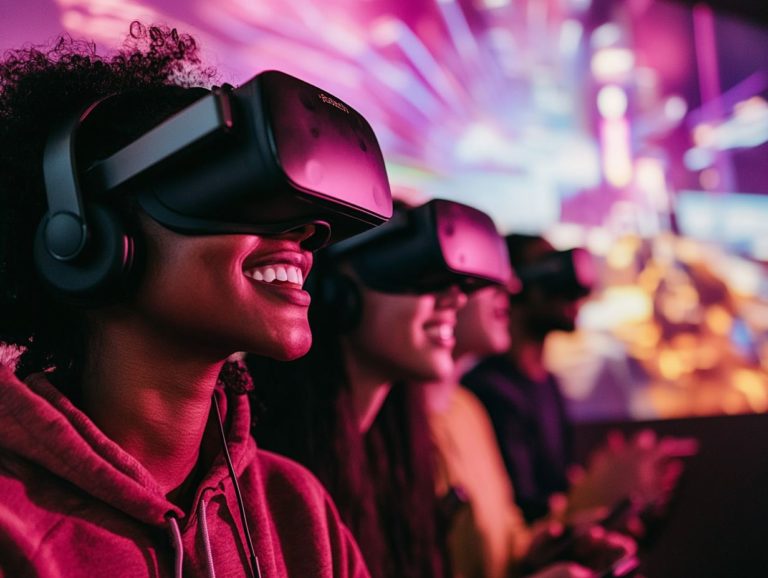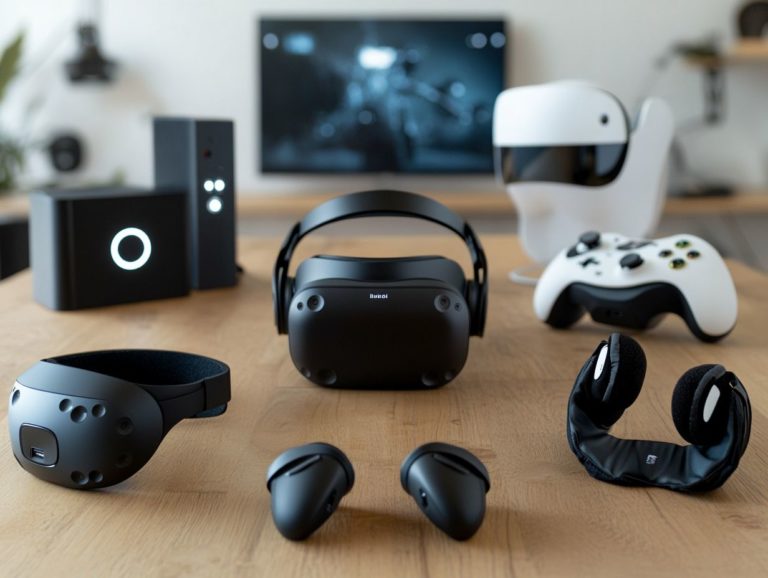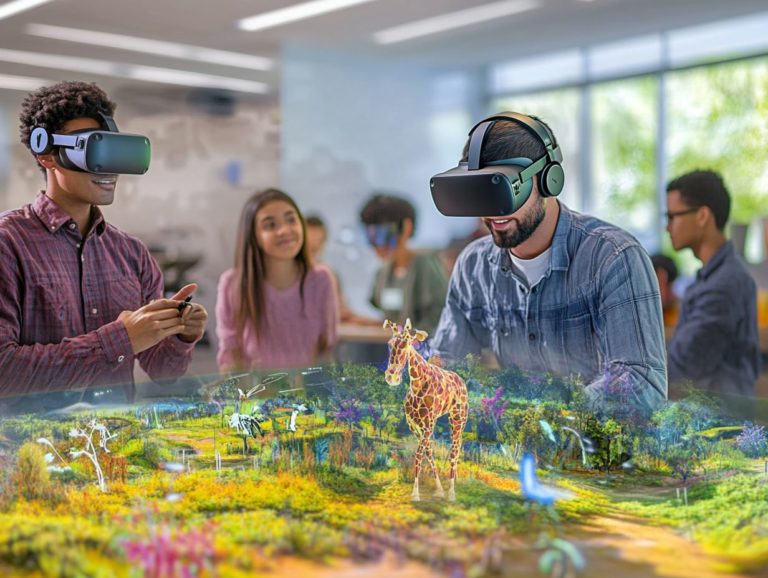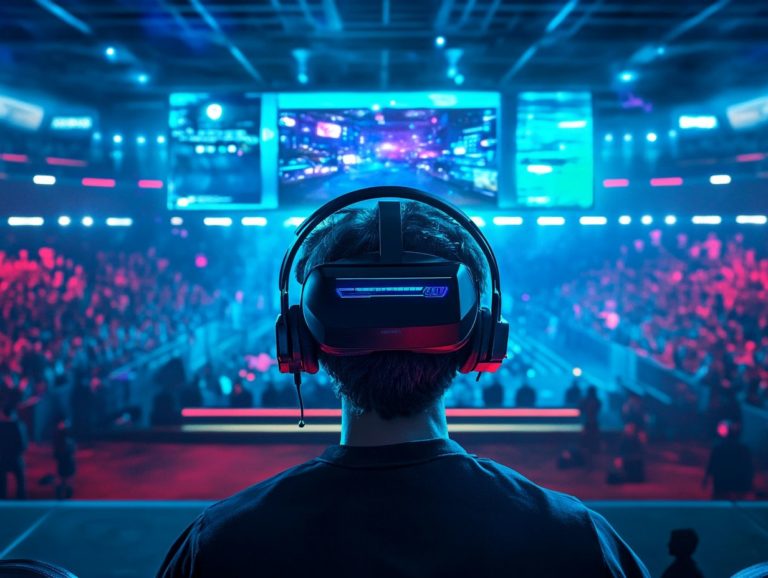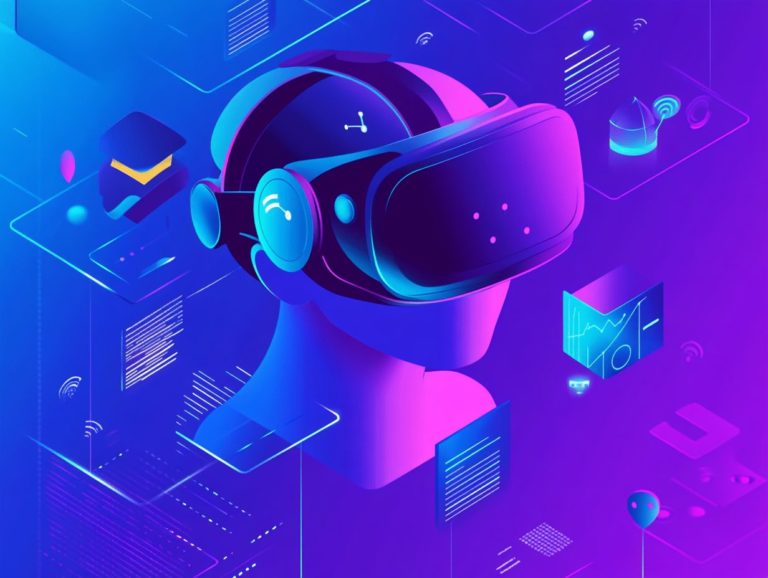explaining vr latency: what gamers should know
In the exhilarating realm of virtual reality (VR), immersion reigns supreme, and latency can either elevate or diminish the entire experience.
Grasping the intricacies of VR latency is crucial for gamers like you who aim to optimize every moment of gameplay. Let s dive into the exciting world of VR latency!
This exploration delves into the essence of latency in VR, examining the many factors that influence it and its profound impact on your gaming performance.
You ll also discover practical tips designed to reduce latency and amplify your VR adventures. Prepare to elevate your gaming experience with these invaluable insights!
Contents
- Key Takeaways:
- Understanding VR Latency
- Factors Affecting VR Latency
- Impact of Latency on VR Gaming
- Ways to Reduce VR Latency
- Tips for Gamers to Minimize Latency
- Preguntas Frecuentes
- Qu es la latencia de VR y por qu es importante que los jugadores lo sepan?
- Cu les son las principales causas de la latencia de VR?
- C mo afecta la latencia de VR a la jugabilidad y la inmersi n?
- Se puede reducir o eliminar completamente la latencia de VR?
- Hay alg n consejo para que los jugadores minimicen los efectos de la latencia de VR?
- C mo pueden los jugadores probar y monitorear la latencia de VR?
Key Takeaways:
VR latency is the delay between a user s action and the corresponding reaction in the virtual environment, and it can significantly affect the gaming experience.
Hardware and software components, such as the graphics processing unit (GPU) and VR headset, play a crucial role in determining VR latency.
To minimize VR latency, gamers should optimize their hardware and settings, as well as follow best practices such as reducing background processes and using a wired internet connection.
Understanding VR Latency
Grasping the intricacies of VR latency is essential for crafting immersive experiences that effortlessly engage users in digital realms.
In the context of virtual reality, latency is the delay between what you do and what you see happening in VR. This delay can stem from various factors, including hardware performance, software optimization, and network stability.
When these elements fall short, it can lead to disruptions that significantly impact the overall user experience.
Defining Latency in VR
Latency in Virtual Reality refers to the delays in visual and audio feedback that can significantly detract from the immersive experience you expect.
This issue becomes particularly problematic in applications where real-time interactions are crucial, such as gaming or training simulations.
Take audio latency, for instance; if there’s a noticeable delay between your actions and the corresponding sound effects, it can lead to a sense of disorientation.
Similarly, response times meaning the lag in graphical updates can create discrepancies in how you perceive your environment, ultimately breaking your sense of presence.
In VR gaming, if your movements aren t reflected on-screen instantaneously, the thrill of the experience can diminish, leaving you feeling somewhat detached from the virtual world.
By illustrating how these delays impact your overall engagement, it becomes evident that minimizing latency is essential for crafting truly immersive virtual experiences.
Factors Affecting VR Latency
Several key factors influence latency in virtual reality, significantly shaping the quality of the immersive experiences you encounter.
Hardware performance is paramount, with the capabilities of your GPU and optimized equipment playing crucial roles.
Software optimization techniques also play a key role in enhancing real-time interactions.
Don t overlook the importance of network stability, especially in multiplayer VR applications.
Tracking system latency can create interaction issues and, in some cases, even lead to motion sickness.
Ensuring all these elements are finely tuned will elevate your virtual experience to new heights.
Hardware and Software Components
The hardware and software components of a VR system greatly influence latency levels, ultimately shaping the quality of your immersive experience.
For example, powerful GPUs are crucial for rendering graphics quickly, ensuring fluidity in the dynamic environments you navigate.
Display technologies like OLED take this a step further, offering faster refresh rates and richer color saturation, which enhance your visual clarity and responsiveness.
On the software side, optimization strategies are key to streamlining data processing and minimizing bottlenecks.
This ensures that every input and motion you make is captured and conveyed with minimal delay.
When these elements work in harmony, they not only reduce latency but also elevate overall performance, creating a more engaging and captivating experience for you in virtual realms.
Impact of Latency on VR Gaming
The impact of latency on VR gaming can dramatically change your gameplay!
When latency disrupts virtual interactions, it becomes increasingly challenging for players to fully engage in their gaming experiences.
High levels of latency can result in problems like motion sickness and reduced performance optimization, ultimately detracting from the overall enjoyment of immersive VR environments.
Start optimizing your VR setup today for the ultimate gaming experience!
How Latency Affects Gameplay
Latency can profoundly influence your gameplay in VR, shaping the immersive experience you strive for. A noticeable delay between your actions and the corresponding response in the virtual environment can lead to frustrating scenarios that undermine the sense of presence VR aims to deliver.
In competitive gaming, even a split second can significantly impact your reaction times and decision-making, potentially giving your opponents an unfair advantage. This highlights the critical need for new technology to fix lag problems.
Solutions like Zero Latency use high-speed networks and optimized hardware to enable smoother interactions, allowing you to navigate your virtual worlds with greater ease and enhancing your overall experience by minimizing lag.
Ways to Reduce VR Latency
Reducing VR latency is essential for elevating your user experience and fostering truly immersive interactions within virtual environments.
To minimize latency, optimize your hardware, utilize advanced software techniques, and ensure network stability. By focusing on these areas, you ll enjoy smoother interactions, enhanced graphics, and an overall boost in performance within your VR applications.
Optimizing Hardware and Settings
Optimizing your hardware and settings in VR technology is crucial for minimizing latency and enhancing overall performance.
By carefully selecting display technologies, whether OLED or LCD, and investing in a powerful GPU that delivers high frame rates, you can significantly improve your VR experience.
Fine-tuning settings such as refresh rates, resolution, and graphical details can lead to even better outcomes. For instance, slightly lowering the resolution can result in smoother gameplay without any noticeable visual trade-offs.
Regularly updating drivers and using performance-enhancing software can further refine your configurations, ensuring that your VR applications run seamlessly.
Taking the time to adjust these components not only reduces latency but also amplifies your immersion in virtual environments.
Tips for Gamers to Minimize Latency
If you re a gamer looking to minimize latency in your VR experiences, embracing specific tips and best practices is crucial for achieving optimal performance.
Understanding the intricacies of latency and its impact on immersive gameplay can give you a competitive edge, enhancing your gaming experience while reducing the risk of motion sickness.
Best Practices for a Smooth VR Experience
Adopting best practices is essential for achieving a seamless VR experience, minimizing latency, and elevating overall user satisfaction.
First, ensure that your graphics card and CPU meet or exceed the recommended specifications for your VR headset. Regularly updating drivers and optimizing system settings can further enhance performance. Fine-tuning software settings such as resolution, frame rates, and anti-aliasing will help eliminate lag, creating a smoother visual experience.
Your physical environment is equally important. Make sure you have ample space free from obstructions and distractions. Good lighting and precise sensor placement can significantly improve tracking accuracy, ultimately enriching the immersive feeling that VR provides.
Preguntas Frecuentes
Qu es la latencia de VR y por qu es importante que los jugadores lo sepan?
La latencia de VR se refiere al retraso entre los movimientos f sicos de un usuario y la respuesta correspondiente en el mundo virtual. Es importante que los jugadores lo sepan porque puede afectar en gran medida su experiencia general de VR, causando mareos y afectando la jugabilidad.
Cu les son las principales causas de la latencia de VR?
Las principales causas de la latencia de VR incluyen limitaciones de hardware, retrasos en el procesamiento e interferencias inal mbricas. Estos factores pueden resultar en retrasos entre los movimientos del usuario y el mundo virtual.
C mo afecta la latencia de VR a la jugabilidad y la inmersi n?
La latencia de VR puede impactar en gran medida la jugabilidad y la inmersi n al causar mareos y romper la sensaci n de presencia en el mundo virtual. Tambi n puede hacer que ciertos movimientos y acciones se sientan retrasados o poco naturales, obstaculizando la experiencia de juego en general.
Se puede reducir o eliminar completamente la latencia de VR?
No se puede eliminar completamente la latencia de VR. Sin embargo, se puede reducir utilizando hardware de alta calidad y ajustando la configuraci n. Tambi n es til minimizar la interferencia inal mbrica.
A n habr cierto nivel de latencia. Es importante tener esto en cuenta al usar tecnolog a VR.
Hay alg n consejo para que los jugadores minimicen los efectos de la latencia de VR?
S , hay algunos consejos tiles para minimizar los efectos de la latencia de VR. Utiliza una conexi n por cable y ajusta la configuraci n gr fica. Adem s, recuerda tomar descansos para evitar mareos.
Elige juegos y experiencias que funcionen bien con VR para reducir problemas de latencia.
C mo pueden los jugadores probar y monitorear la latencia de VR?
Existen varias herramientas y software disponibles para ayudar a los jugadores a probar y monitorear la latencia de VR. Por ejemplo, SteamVR Performance Test y Oculus Tray Tool son opciones efectivas.
Estas herramientas muestran datos de rendimiento en tiempo real y ayudan a identificar problemas de latencia que requieren atenci n.

